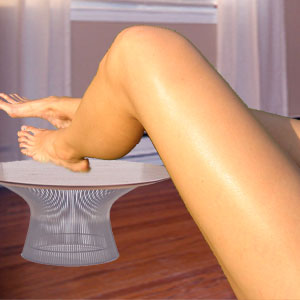Pregnancy Varicose Veins

Swollen veins that bulge near the surface of the skin are called varicose veins. They appear blue or purple and usually show up as a cluster on the legs. The skin around the varicose vein may itch, pulsate, or induce a burning sensation. The symptoms worsen at the end of the day if you have been on your feet for very long.
Varicose veins are a common problem faced by pregnant women. These Varicose Veins can impede normal blood flow and result in edema, thrombosis, hemorrhage or ulceration. Some women suffer piles (hemorrhoid), which are varicose veins in the rectal area. A few women develop varicose veins around the vagina. During pregnancy, the uterus presses against the large blood vessels in the abdomen and pelvis, often causing varicose veins.
These blood vessels carry blood from the legs back up to the heart. This pressure slows down the blood flow thereby overfilling the veins in the legs. Besides, the rising progesterone levels cause the blood vessels to relax.
Varicose veins are clearly visible during the third trimester. The National Institute of Health estimates that about 60% of men and women suffer from vein disorder. According to Professor Robert A Weiss of Johns Hopkins University, 'the real working venous system for the leg lies deeper'. This means that if the surface veins begin to clump and bulge, they can be destroyed without ruining blood circulation to the leg.
Any inflammation of the veins is called as Phlebitis which may be the result of an infection, injury or poor circulation. It can also result from systemic damage to valves of the veins. Such inflammation may cause formation of a blood clot - thrombophlebitis. Although thrombophlebitis can occur in any veins, when it involves the deep veins that results in Deep Vein Thrombosis (DVT), it can be serious. Typically DVTs appear in the deep veins of the legs where they cause serious restriction in venous drainage.
Understanding Varicose veins
The different types of varicose veins are:
Trunk varicose veins are close to the surface of the skin and are thick and knobbly.
Reticular varicose veins are red and are sometimes grouped close together in a network.
Telangiectasia varicose veins are small clusters of blue or red. They are harmless and do not bulge under the skin surface. They are also referred to as thread veins or spider veins.
While the bumpy snake-like swollen vessels are found predominantly in the legs, varicose veins can show up anywhere in the lower half of your body. These purplish bulges which you love to hate cannot be concealed by stockings. Varicose veins are most common during pregnancy but they also tend to get better or even disappear three to four months of the baby's birth.
- Discomfort, a few might not experience any discomfort at all.
- Heaviness in the legs
- Excessive pain
Pregnancy varicose veins cause
The good news is that varicose veins can itch or ache but they do not put you or your baby at risk. In case you did not have them before you got pregnant, chances are varicose veins shrink or disappear altogether within a few months after you give birth. But chances are varicose veins will reappear when you are pregnant the next time. Significantly, like stretch marks and other pregnancy symptoms, varicose veins tend to be hereditary. If your mother had them during pregnancy, most likely your daughter will have them too.
- Sudden weight gain
- Female sex hormones weaken the walls of the veins thus making them slack.
- Family history of varicose veins during pregnancy
- Standing or sitting for excessively long periods
- Multiple pregnancy
Pregnancy varicose veins prevention
Simple lifestyle changes can prevent or minimize varicose veins.
- Exercise regularly, go for walks
- Remain active
- Avoid standing or sitting for long. Move around every hour or so.
- Do not cross your ankles while sitting. Use a footstool.
- While lying down, elevate your legs
- Follow a low-sodium diet
- Sleep on your left side; it relieves the right side vein of the weight of the uterus thus decreasing the pressure on the veins in the leg and feet.
- Try to remain within the recommended weight frame
- Wear clothes that constrict the blood vessels in your legs
- Wear support hosiery. You can use maternity support tights and stockings. These can prevent blood pooling in the legs.
Varicose veins treatment
Varicose veins will settle down by its own after delivery. It generally takes three to four months for them to settle down. It is advisable to consult a healthcare provider if these veins cause any discomfort. Compression stockings are specifically designed to squeeze the legs and improve blood circulation. They are tight at the ankle and encourage blood flow the heart. They are typically worn throughout the day when you are up and about.
Sclerotherapy uses chemical foam to shut the affected vein. The chemical or sclerosant damages and scars the inner lining of the vein causing it to close. Compression stockings or elastic bands are recommended for a few weeks to prevent the blood from returning after you stand up. Repeated sessions might be necessary. Sclerotherapy can lead to side effects such as lower back pain, blood clots in other veins and fainting.
Vein Stripping and Ligation involves tying up the veins and removing them through cuts made on the skin. Ligation and stripping can cause pain, bruising and bleeding. There is a risk of nerve damage or blood clot formation.
Phlebectomy is used to treat varicose veins close to the skin's surface. Small cuts are made on the skin to remove the varicose veins.
Endothermal ablation uses high-frequency radio waves or laser to seal affected varicose veins. After heating the vein with radio waves, a catheter is guided into it to seal it shut.
Endovenous Ablation Therapy uses lasers to close off varicose veins. The tiny laser is passed through a catheter to the affected veins. The short bursts of energy delivered by the laser heat up the vein and seal it shut.
Top of the Page: Pregnancy Varicose Veins
Tags:#pregnancy varicose veins #pregnancy varicose veins treatment
 Planning Pregnancy
Planning Pregnancy Pregnancy Diet and Exercise
Healthy Weight Gain in Pregnancy
Pregnancy Food Cravings
Pregnancy Heartburn
Improving Fertility after 35
Ovulation Test Strips
Pregnancy Symptoms
Early pregnancy cramping
Early pregnancy Test
High Risk Pregnancy
More on Pregnancy
 Natural Childbirth
Natural Childbirth Premature Birth
Pregnancy Massage
Pregnancy Problem
Pregnancy Due Date Calculator
Amniocentesis
Twin Pregnancy
Ectopic Pregnancy
Pregnancy Morning Sickness
Molar Pregnancy
Pregnancy Ultrasound
Constipation during pregnancy
Insomnia during Pregnancy
Smoking during Pregnancy
Teen Pregnancy
Exercise during pregnancy
Late Term Abortion
Sign of Miscarriage
Pregnancy Fatigue
Pregnancy Gas
Pregnancy sciatica
Belly Wrap after Pregnancy
Emotional Health during Pregnancy
Lactating Mother
Infertility
Recurrent Miscarriage
Pregnancy Varicose Veins
Postpartum Depression
Epidural
Premature Infant
Top of the Page: Pregnancy Varicose Veins
Popularity Index: 100,863

